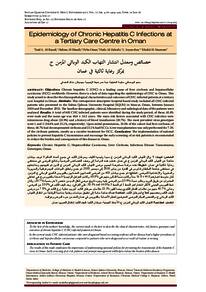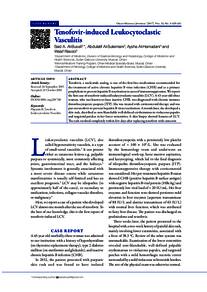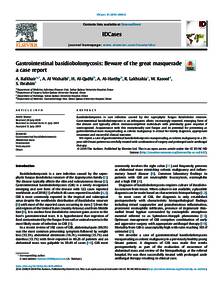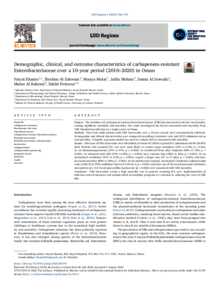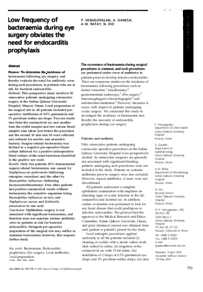Document
Epidemiology of chronic hepatitis C infections at a tertiary care centre in Oman.
Identifier
DOI: 10.18295/squmj.2017.17.04.005
Contributors
Al-Shuailiyah, Halima., Author
Omar, Heba., Author
Al-Zuhaibiyah, Haifa., Author
Jeyaseelan, L., Author
Other titles
خصائص ومعدل انتشار التهاب الكبد الوبائي المزمن ج بمركز رعاية ثالثية في عمان
Publisher
College of Medicine, Sultan Qaboos University.
Gregorian
2017-11
Language
English
English abstract
Objectives: Chronic hepatitis C (CHC) is a leading cause of liver cirrhosis and hepatocellular
carcinoma (HCC) worldwide. However, there is a lack of data regarding the epidemiology of CHC in Oman. This
study aimed to describe the clinicopathological characteristics and outcomes of CHC-infected patients at a tertiary
care hospital in Oman. Methods: This retrospective descriptive hospital-based study included all CHC-infected
patients who presented to the Sultan Qaboos University Hospital (SQUH) in Muscat, Oman, between January
2010 and December 2015. The baseline demographic, clinical, laboratory and radiological data of the patients were
analysed.
Results: A total of 603 CHC-infected patients were identified during the study period; of these, 65.8%
were male and the mean age was 44.8 ± 16.5 years. The main risk factors associated with CHC infection were
intravenous drug abuse (23.9%) and a history of blood transfusions (20.7%). The most prevalent virus genotypes
were 1 and 3 (44.0% and 35.1%, respectively). Upon initial presentation, 33.0% of the cohort had liver cirrhosis; of
these, 48.7% had decompensated cirrhosis and 23.1% had HCCs. Liver transplantation was only performed for 7.5%
of the cirrhosis patients, mostly as a curative treatment for HCC. Conclusion: The implementation of national
policies to prevent hepatitis C transmission and encourage the early screening of at-risk patients is recommended
to reduce the burden and consequences of this disease in Oman.
Member of
Resource URL
Citation
Al-Busafi, Said A., Al-Shuailiyah, Halima, Omar, Heba, Al-Zuhaibiyah, Haifa, Jeyaseelan, L., & Al-Naamani, Khalid (2017). Epidemiology of Chronic Hepatitis C Infections at a Tertiary Care Centre in Oman. Sultan Qaboos University Medical Journal, 17 (4), 4
Arabic abstract
الهدف: لا يزال التهاب الكبد الوبائي المزمن ج سببا رئيسيا لتليف وسرطان الكبد في . جميع أنحاء العالم لا توجد بيانات متاحة عن التهاب الكبد الوبائي المزمن ج في عمان، هدفت هذه الدراسة إلى وصف الخصائص المرضية ونتائج المرضى في مستشفى رعاية ثالثية في عمان الطريقة: هذه دراسة مستعرضة لجميع مرضى التهاب الكبد الوبائي المزمن ج الذين تم تقييمهم ومتابعتهم في مستشفى جامعة السلطان قابوس في الفترة من يناير 2010 إلى ديسمبر 2015. تم جمع وتحليل البيانات الديموغرافية والسريرية والمخبرية والإشعاعية للمرضى. النتائج: تم جمع بيانات 603 من المرضى العمانيين المصابين بالفيروس الكبدي الوبائي ج المزمن كان متوسط اعمارهم 44.8 ± 16.5 سنة وكانت نسبة الذكور منهم هي 65.8% وكانت العوامل الرئيسية لاصابة بالفيروس ج هي تعاطي المخدرات عن طريق الوريد ومثلت نسبة (% 23.9 )من المرضى يلية وجود تاريخ مرضي لنقل الدم من شخص لآخر بنسبة (20.7%) وكان نمط الفيروس الجيني الأكثر انتشارا هو النمط 1 ثم النمط 3 (44.0% and 35.1%,. على التوالي)، وجد تليف الكبد في %33.0 من المرضى. وعاني 48% منهم من علامات الفشل الكبدي بينما أظهر 23.1% علامات سرطان الكبد، أجريت عملية زرع الكبد في % 7.5 من مرضى تليف الكبد ومعضمهم كعلاج لسرطان الكبد. الخلاصة: هناك حاجة ماسة إلى تطبيق سياسات وطنية مناسبة للوقاية من انتقال التهاب الكبد الوبائي ج، والفحص المبكر للمرضى المعرضين لخطر الأصابة بالفيروس في عمان للحد من عبء المرض وعواقبه.
Category
Journal articles

